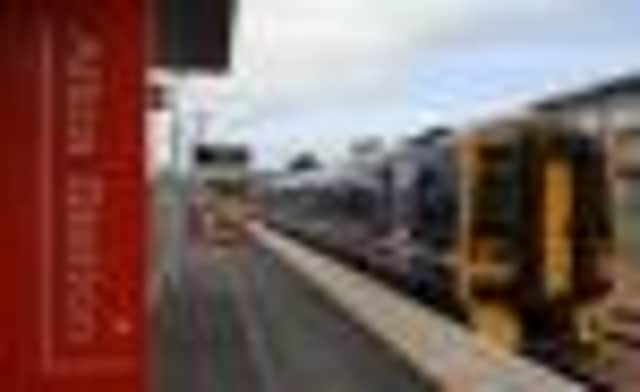£1 million repair bill for Stirling-Alloa-Kincardine rail route


Network Rail has revealed that around half of the total £2 million spent on the Stirling-Alloa-Kincardine route since it opened four years ago has been spent on curing “snagging” faults.
This is in addition to a lengthy list of work carried out by the contractors to fix defects. The cost of these has not been disclosed but insiders say the new £1 million bill is twice as much as expected for a brand new line.
Advertisement
Hide AdAdvertisement
Hide AdThe ongoing repairs have been prompted in part by complaints from residents kept awake by long, heavy coal trains on the line en route to Longannet Power Station, near Kincardine in Fife. Network Rail says it is considering spending more on “acoustic fences” to muffle the sound.
The improvements already carried out include placing extra ballast under the tracks and realigning rails to create a smoother and quieter path for passenger and freight trains.
Passenger trains run over half of the line, as far east as Alloa, reconnecting the Clackmannanshire town to the rail network after a gap of 40 years. Mid-Scotland and Fife Labour MSP Dr Richard Simpson blamed the Scottish Government’s transport agency for not ensuring the line was built effectively.
He said: “Transport Scotland has failed to ensure the original line was in a fit state. A lot of additional ballast has been required, but it still has not resolved the noise problem.”
Simpson said he would be contacting the Scottish Human Rights Commission because night-time noise levels beside the line breached World Health Organisation standards, affecting 69 homes.
He said: “The noise is at shocking levels. Every time I talk about it my blood pressure goes through the roof.”
The line has been beset with problems since it was the first new railway to be approved by the Scottish Parliament in 2004. Its costs rocketed from £37m to £85m and completion was two and a half years late. The problems centred on poor management of the project, which was overseen by Clackmannanshire Council and the now-scrapped City of Edinburgh Council transport body Tie, before being taken over by Transport Scotland in 2007.
An Audit Scotland report the following year blamed “weak project governance” and “misaligned roles and responsibilities” for the fiasco.
Advertisement
Hide AdAdvertisement
Hide AdAn industry expert agreed that the fault lay with the way the project had been handled rather than the construction firms involved – BAM Nuttall and Babcock Rail.
They said: “It was not about tatty nails or poor workmanship but design issues. The contractors were pulling their hair out about the management of the project. They just built what they were told to build.”
After the line opened, it had to be shut again for four weekends for track repairs, with other faults including level crossing barriers failing to rise after trains passed. This left motorists stranded for up to an hour because of the lack of alternative routes.
The contractors have also had to fix, at their own expense, dozens of other items on an “outstanding works list” agreed with Transport Scotland, such as defects to electrical equipment, signalling and structures.
Network Rail, which runs tracks and signals, confirmed it had had to do extra work on the line, which it was not involved in building. The firm was unable to say how much this had added to its total spending on the route.
A spokesman said: “Since the line became operational in 2008, we have undertaken snagging work following construction as well as planned and reactive maintenance.
“We have also undertaken some renewals work in relation to the existing operational railway. Since 2008, Network Rail has spent in the region of £500,000 per annum on snagging work and maintenance including track drainage systems, additional ballast, tamping [packing down ballast] and lining [rails] as well as usual day-to-day maintenance.
“Snagging issues are not unusual with a newly constructed line, and given the severe weather experienced since 2008 and the freight and passenger usage of the line, this was broadly what we expected… and therefore what we budgeted for.”
Advertisement
Hide AdAdvertisement
Hide AdThe spokesman said the firm was checking the state of the line so it could budget for “future interventions and maintenance” over its next spending period, from 2014.
A Transport Scotland spokesman said: “It is normal industry practice to undertake snagging and maintenance works to newly constructed railway lines and considering the recent severe winters we would expect some repairs to be undertaken. Network Rail is responsible for operating and maintaining Scotland’s rail infrastructure.
“The return of the rail service to Clackmannanshire has been a positive development for the local and national economy and the environment. In the first year of operation alone, 400,000 passengers took advantage of the new service.”
BAM Nuttall and Babcock Rail declined to comment.